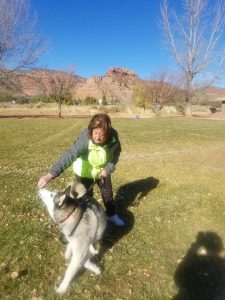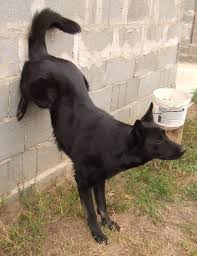Training tricks is a lot of fun for you and your dog. And it is a valuable tool to improve your communication with your dog, and improve your training skills.
Why train dog tricks?

Often my clients say they don’t want to train dog tricks. They think it is frivolous, and want to concentrate on obedience cues and general behavior. I don’t separate obedience cues from tricks. To me it is all the same. Sit, down, stay, come. They are tricks/they are obedience cues. Bring me a dumbbell or toy and drop it in my hand–trick or obedience? Both. Same for heeling, recall, etc. Okay, it could be argued roll over, sit pretty, cover your eyes aren’t obedience cues. But it is teaching your dog to do a specific behavior when asked. Isn’t that the definition of an obedience cue?
Having fun improves your communication with your dog.
You need a connection with your dog in order to be successful training him. Many people get into ordering their dog to do things. That isn’t much fun for either of your. When you train tricks, most people are in a lighter mood, it isn’t as serious to them. The dogs respond to this more upbeat mood, and you’ll notice tails wagging more and happy doggy grins. And the result is better communication because you’re in a better place with your dog.

Break it down into small slices.
You want to train a specific trick. First think what you want the finished trick to look like (this may change as you get training it). Then for the dog to understand it and perform it, you have to divide it into small pieces or slices. There are many ways to train a specific trick, but the first step is always thinking how you are going to explain to the dog what you want him to do.
So let’s say you want to teach Rover to spin. You want him to turn in a tight circle, with a hand gesture or a verbal cue. Let’s break that into slices or steps.
* Have a treat at Rover’s nose level, and keeping it right at his nose, have him turn his head to follow it and then give it to him (click and treat if using a clicker).
* Have him follow it further around in a circle, always keeping the treat right at his nose, giving it to him before he stops following it. If the treat is too high, he’ll either sit down or jump for it. Keep it at his nose level.
* Continue this, gradually increasing how far he turns, until he makes a complete circle. (This may be a few times, or several sessions).
 * When he is spinning (turning) easily, have the treat in your other hand and lure him with your empty hand. If he does it, immediately give him the treat. You may have to lure with the treat occasionally.
* When he is spinning (turning) easily, have the treat in your other hand and lure him with your empty hand. If he does it, immediately give him the treat. You may have to lure with the treat occasionally.
* Gradually make the cue (your luring hand) into a more subtle gesture. At a height comfortable for you. This may have to be broken into many slices–gradually making a smaller or higher gesture, or whatever you want to end up with. Remember that the treat is now a reward, not a lure. But he needs the reward each time he does it until you feel he really has it (does it promptly 9 out of 10 tries). Then you can start varying the reward schedule (reward the best spins, or when there are distractions, or 2 out of 3, or whatever).
* Add your verbal cue. Say the word “spin” or whatever, then cue the spin. Then say “spin”, pause 1 or 2 seconds, then use the hand cue. Some dogs catch on quickly, some take a while, but if he is getting rewarded for the spin, he will eventually do it from the verbal cue, before you do the hand cue.
That was 6 main steps. But for many dogs it would actually be many more, because turning might be broken into head turn, turn several inches in circle, turn 6 inches in circle, turn half-way, etc. The point is, you need to break the main task into smaller pieces, so the dog catches on.
You will become a better trainer teaching tricks.

Deciding to train a trick, dividing it into slices, finding ways to communicate what you want to your dog–this will make you a better trainer. And think how rewarding it will be to show off Rover’s new trick!
You will gain more understanding of how your dog thinks, as you find what works to make it clear to him and what doesn’t. Yes, you won’t always be successful at first, but pay attention to your dog and you and he will figure it out. And that is really satisfying! In the above example, you had to find the best height for the lure, how fast you could move it and still have Rover follow it, how far you could move it each time, when could you get the treat out of the luring hand, etc. That is a huge amount of information you learned about training your dog, all while teaching him a fun trick! Pretty cool!
If you want a good book to help you get started training some tricks (or want some ideas for some new tricks to train, check out Kyra Sundance’s book 101 Dog Tricks.
Remember to let your dog know you’re having fun!
Don’t be shy about letting your dog know you are having fun! It will increase his fun immensely. In theory, if you are using a clicker, you don’t need to praise as well. Click means you did it! You get a treat!
I find that if I get excited (because I do), and verbally praise, my dogs get more animated and work harder. Every trainer and every dog will have his own style. Some dogs may be distracted by the verbal praise, or cheering may be too much for them. Pay attention to your dog. He will tell you what he likes! As Suzanne Clothier says, you want to ask your dog “How is this for you?”. Wise words!
But keep it light. Smile–dogs really respond. Have fun, and your dog will. And that will be even more fun for you!
How has training tricks helped you and your dog? What tricks have been the most fun for you to train? Leave us a comment below and let us know!
So true! Having fun is key. I have discovered that my dog is more responsive if I have an upbeat tone in my voice. If I am happy, he is happy.
So true! Dogs key in to our moods, and respond in kind. If we are stressed or distracted our dogs really pick up on it. If we are cheerful and upbeat, our dogs love it! If they think you are having fun, they like it and have fun too. And doesn’t that work both ways?
You explain these tricks so well, the way we need our dog to obey, and the difference between tricks. The obedience is down-packed, sit, stay. We are moving on to tricks, roll-over; you break down this trick to help me train my dog to do tricks.
Your article will keep as a reference us in teaching our dog tricks.
We do know others that will benefit from this as well.
Cheers,
Mathew&Deloris
Hi Mathew and Deloris
I’m glad you found the post helpful. I love teaching tricks, as the dogs really learn a lot while having a great time. What could be better? And we humans learn so much about communicating with our dogs. Happy training! Keith